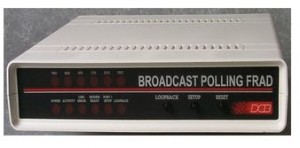DCB SCADA FRAD

BPF-01 Broadcast Polling FRAD, Single Port
BPF-04 Broadcast Polling FRAD, 4 Port
BPF-08 Broadcast Polling FRAD, 8 Port
BPF-16 Broadcast Polling FRAD, 16 Port
BPFC-01 Broadcast Polling FRAD, Single Port, Conitel bit Protocol
BPFC-02 Broadcast Polling FRAD, Two Port, Conitel bit Protocol
BPF-BU Broadcast Polling FRAD, Backup Option
/DSU Add for Internal 56/64K DSU
/12, 24 or 48 Add for 12, 24, 48 VDC power option
/125DC Add for 125VDC power option
The DCB BPF Frame Relay Broadcast Polling FRAD (frame relay access device) is a FRAD for async networks that will accommodate almost any byte oriented async polling protocol. Proven protocols include DNP-3, Modbus ASCII, Modbus RTU, Telegyr, Harris, and many others. A special version of the BPF supports the 31 bit Leads and Northrup Conitel Protocol. The FRAD encapsulates async polling protocols into frame relay format for private or public frame relay networks. The BPF is easily configured. A host BPF port is simply mapped to the remote DLCIs that will receive the host polling data. No detailed knowledge of the SCADA system’s internal polling protocols is required.
The BPF makes it easy to convert async polling networks from multipoint modems to frame relay networks. Analog line facilities are being priced out of the market by digital facilities. At the same time, async polling system speed requirements are increasing from 1200 to 9600 bps and faster. Remote terminal units are becoming more capable, more data must be exchanged from the host to the remote units for financial, traffic control and SCADA networks. The BPF is the ideal product for this requirement. It supports async port speeds up to 57.6 Kbps and synchronous frame relay composite speeds to 128 Kbps.
The BPF is often more cost effective than analog high speed fast polling modems. Frame relay networks are becoming less expensive than analog networks, DSU’s are less expensive than modems. The hardware cost savings provides a compelling reason to use the BPF.
The BPF can have 1 or 4 ports wite up to 40 DLCI’s defined per port or 8 or 16 ports with up to 20 DLCI’s defined per port. For example, a BPF-04 unit can be used to create 4 different SCADA polling networks via DLCI mapping using the same frame relay network. For systems larger than 16 host ports, a host frame relay switch is used. Contact DCB for more details. This allows multiple SCADA systems to be used over the same wide area network. For example, a power load-control system and substation automation systems may be run simultaneously over the same BPF system.
The BPF toggles RS-232 control leads as data goes out the port, and turns them off milliseconds after the data has exited the port. It also keeps blocks of up to 1024 bytes together, blocks that are output contiguously to avoid time out errors common to SCADA polling systems. This is the only FRAD that we’ve found to be totally reliable with SCADA protocols.
A one port BPF reads the DLCI number automatically from the frame relay network full status message. The larger BPF units require that the DCLI be explicitly set. The DLCI numbers can be duplicated on the ports of the multi-port BPF, allowing it to be used as a sharing device at a remote location.
Special firmware is available for 31 bit Conitel and similar synchronous protocols. The BPF reads the long data words and transmits them to the far end via frame relay. The 31 bit long data words are reconstructed at the far end and sent on to the RTU. DCB can supply 202T FSK modems for older RTU’s that have embedded FSK modems.
The BPF firmware may also be customized for special and one-of-a-kind protocols. Versions are available for 11 bit word protocols, Racal Redac, and other protocols.
Another special version provides for automatic private line or dial line backup. If the frame relay link is lost, the remote BPF will automatically check the private line port and the dial up port to establish a backup link. When the frame relay link is re-established, the BPF automatically drops the dial backup link and reverts to frame relay again. Click here for a data sheet on how the backup operates. Standard firmware allows for redundant hosts, even at different locations.
BPF units have timers, buffers, control signal handling and data checking to accommodate typical SCADA equipment. And, with an internal DSU, you get the entire package in a single enclosure.